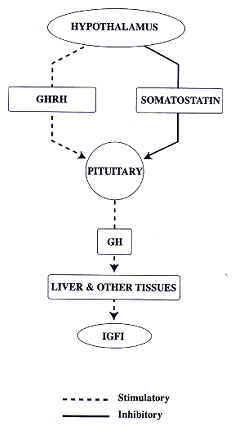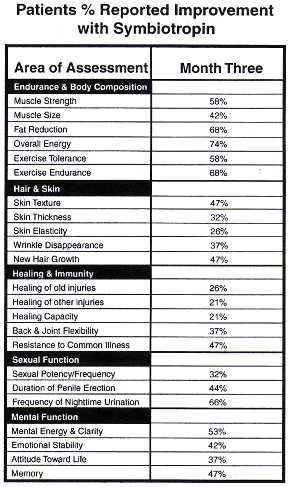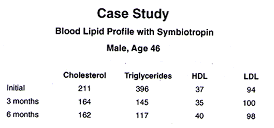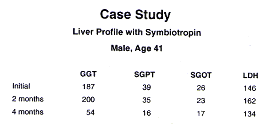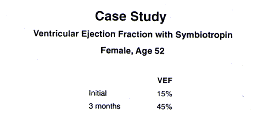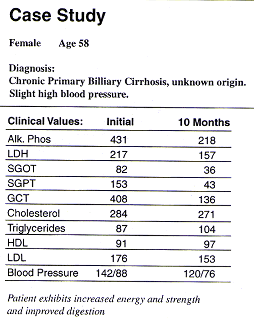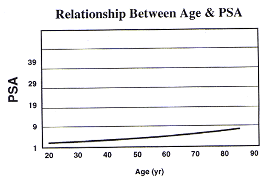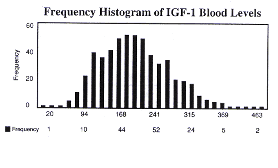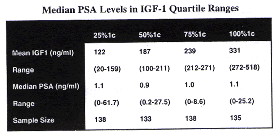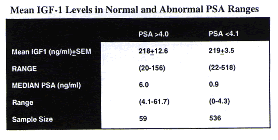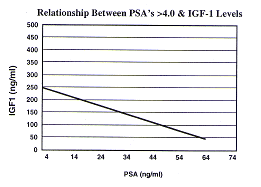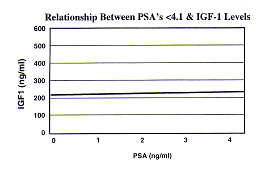
|
|
|
|||||||||||||||||||||||||||||||||||||||||||||||||||||||||||||||||||||||||||||||||||||||
The Role of Oral
Growth Hormone Secretagogues in Anti-Aging Therapy Background Based on the increasing body of evidence that adults with human growth hormone (hGH) deficiency exhibit signs of impaired health, many countries have approved the use of hGH (somatotropin) as a replacement therapy in deficient adults. The results and efficacy of hGH therapy are strikingly consistent. Untreated hGH deficient adults are shown to have increased cardiovascular mortality, reduced skeletal muscle strength, reduced exercise capacity, reduced glomerular filtration and renal plasma flow, defective thermo-regulation and sweat secretion, reduced energy expenditure and basal metabolic rate, reduced myocardial function, clinical signs of premature atherosclerosis, and abnormal thyroid metabolism. Body composition has been found to be abnormal in these patients, as evidenced by decreased lean body mass, increased fat mass, visceral obesity, reduced bone mineral content, and reduced extracellular fluid volume, while independent groups have reported impaired psychological well being. Somatotropin deficiency has distinct clinical consequences, all of which can be totally or partially alleviated by rhGH replacement therapy. Safety and cost considerations associated with growth hormone replacement have generated interest in several research studies focused on oral growth hormone releasers, also known as hGH secretagogues. This class of compounds works by directly stimulating the pituitary to release hGH and by affecting contiguous endocrine organs, like the hypothalamus. There are several known factors that affect hGH release and response, including insulin regulation, somatotroph receptors, GHRH, somatostatin, liver function, and IGF-1 receptor sites. 8-10, 17 Pharmacologically correlating these factors with the action of the anterior pituitary peptides, a sequenced glycoamino acid complex, and botanical regulators of insulin and IGF-1 has led to the development of Symbiotropin, which promotes hGH release & IGF-1 formation. Clinically, the efficacy of Symbiotropin has been evaluated through IGF-1 measurements and patient self-assessments.
Somatotropin is secreted by somatotrophs located in the anterior portion of the pituitary gland. Somatotropin secretion peaks during adolescence when accelerated growth occurs. After age 30, secretion decreases by about 14% per decade.
It is known that the aging pituitary somatotroph cells are capable of secreting as much hGH as the young somatotroph cells when they are adequately stimulated. The primary influences on age-related decrease in hGH secretion include reduced production of GHRH and increased production of Somatostatin, the hypothalamic inhibitor of hGH release. Research has shown that aging leads to reduced responsiveness of the precursor hormone GHRH to signals from the hypothalamus. Research also suggests that overall metabolic response to available hGH diminishes due to decreased sensitivity of cellular receptor sites. Some hGH secretagogues work by stimulating GHRH, inhibiting somatostatin, and/or affecting pituitary receptors that are not yet clearly defined. 5, 8, 9 The physiological effects associated with hGH are now assessed through the evaluation of IGF-1. Circulating hGH (1/2 life = 20 minutes) stimulates the liver to release IGF-1 (1/2 life = 20 hours). Serum IGF-1 levels are more sustained, and therefore a more practical indicator of growth hormone status. hGH improves utilization of fat as a source of energy by stimulating lipolysis and fat oxidation. The significance of these effects is reflected in the finding of increased adiposity in hGH deficiency and reduced fat mass in acromegaly. Studies under fully controlled conditions in vitro have indicated that cortisol and insulin facilitate lipid accumulation by expressing lipoprotein lipase (LPL). hGH and testosterone inhibit the expression of LPL, which markedly stimulates lipolysis. 16 hGH affects protein metabolism in a manner that increases lean body mass through stimulation of protein synthesis, and reduction of protein oxidation. It does not inhibit protein catabolism. 21 Long term IGF-1 deficiency affects carbohydrate metabolism, leading to insulin resistance and exacerbated obesity. These effects can be reversed with hGH therapy. hGH increases glucose turnover, making it more readily available metabolically as a primary fuel. Characteristics of GH Deficiency Anabolic Tone Reduced lean body mass and/or skeletal
muscle mass Elevated LDL cholesterol Osteopenia (lack of bone) Insulin resistance (in obese people)
Thin skin Reduced glomerular filtration and
renal plasma flow Reduced energy Action of Secretagogues Functional studies demonstrated that GHRH and secretagogues act through different mechanisms, and distinct receptor sites. Somatotrophs stimulated with secretagogues release hGH in response to both GHRH and the secretagogue. Efficacious secretagogue peptides, work at the level of the hypothalamus, to affect hGH releasing factors, and at the level of the pituitary to release stored hGH in a synergistic fashion. Pituitary receptors have been identified that respond to specific hGH releasing peptides. 10, 17 Since somatostatin increases with age to lower levels of hGH, it is important for effective secretagogue peptides to inhibit the action of this hormone. Hypothalamic receptors have been identified that respond to peptides that inhibit somatostatin and stimulate GHRH. Many studies have evaluated the effectiveness of oral amino acids and peptides. Oral absorption studies have demonstrated very erratic absorption rates. Orally ingested peptides must be formulated in a delivery system that will endure the acid pH of the stomach in order to be absorbed effectively and arrive at appropriate receptor sites. Absorption of the hGH molecule has been examined through various means of delivery, e.g. mucosal surfaces, the mouth and nose. These studies have demonstrated very ineffective absorption rates of around 5-10 %. Studies indicate that absorption rate and efficacy of amino acid secretagogues are enhanced when administered in a carbonated solution. 1, 2, 3 Management of hGH secretion through the use of peptides and other synergistic compounds has been shown to increase the amplitude and frequency of hGH release within age-related physiologic boundaries. Clinical Results Thirty-six individuals were evaluated clinically for changes in existing symptomatology and serum IGF-1 levels over a period of 12 weeks while being administered Symbiotropin, a combination or anterior pituitary peptides, sequenced glycoamino acid complex, phamaceutical saccharides, and botanical regulators of insulin and IGF-1. Initial IGF-1 measurements ranged from 21 to 276. Patients were instructed to take two Symbiotropin effervescent tablets dissolved in water four hours after the last meal and prior to retiring. This schedule was maintained in five-day cycles, with two days separating each cycle for a term of twelve weeks. IGF-1 levels were measured before the onset of Symbiotropin therapy and then at four week intervals. Patient self-assessments were performed every four weeks throughout the twelve week term. Additional clinical observations were made during routine office visits. Patient self-assessments in areas of endurance and body composition, hair and skin, sexual function, healing and immunity, and mental function reflect significant improvement in all 23 areas of evaluation, with range of 21% - 74% of patients reporting improvement in these areas. Additional clinical observations reflect significant improvement in blood sugar management in diabetic patients, lowered prostate-specific antigen (PSA), improved cardiac and pulmonary function, blood pressure management, and improvement in menopausal symptoms. Areas of IGF-1 Activity Synthesized by Leukocytes
No side effects were observed that could be attributed to Symbiotropin. One female patient was removed from the study due to a citric acid allergy that was aggravated by Symbiotropin. IGF-1 measurements indicate an overall increase in IGF-1 throughout the twelve week term. Measurements taken during the first four weeks indicate increases of over 200% and averaging over 18%. Eight week measurements indicate increases of over 100% and averaging 24%. Twelve week measurements indicate a 30% average increase in IGF-1. Rate of symptomatic response occurred independent of the rate of IGF-1 increase such that fluctuations in IGF-1 measurements were associated with concurrent symptomatic improvements, even when IGF-1 levels are decreased. Case Studies In the case of a 46 year old male,
after 6 months of therapy with Symbiotropin, significant reductions in total
cholesterol and triglycerides were observed. HDL was also increased by nearly
10%. A 10% increase in HDL has been shown to correlate to a reduction on a cardiovascular
mortality by 35%. In this 41 year old male, significant
reductions in elevated liver enzymes were observed with four months of therapy. In the case of a 52 year old female,
the left ventricular ejection fraction (LVEF) improved from 15% to 45% after
3 months of therapy. LVEF was evaluated with color Doppler echocardiography. In a 58 year old female with chronic
primary biliary cirrhosis - liver function tests, LDL's, and blood pressure
all improved with ten months of therapy
IGF-1 and Prostate Cancer A recent study presented by Cass Terry, MD analyzed the relationship of IGF-1 levels and prostate cancer in 749 men. Because IGF-1 is mitogenic, and may effect cell differentiation, its role in increasing prostate cancer was evaluated. The incidence of prostate cancer increases with age, whereas blood levels of IGF-1 decline significantly with age, at about 14% per decade after the age of thirty.
This frequency histogram of IGF-1 blood levels includes 593 patients aged 22 to 86 years many of whom were on hGH injections. The dosage ranged from 4-10 IU's per week, in twice daily injections. Mean age of all men was 55.1 years.
This table demonstrates no correlation between IGF-1 and median PSA levels, when comparing the highest and lowest quartiles.
This table grouped PSA levels greater than 4.0 ng/ml, and PSA levels less than 4.1 ng/ml. There was no correlation between PSA and IGF-1 levels in the group of men with a PSA of less than 4.1. In the group of men with PSA levels greater than 4.0, there was a negative correlation between PSA and IGF-1 levels. A significant finding was that the mean IGF-1 levels were essentially the same in both groups, but the median PSA in the group who had PSA levels greater than 4.0 had median PSA levels that were greater than 6 times higher than the group with values less than 4.1.
This graph demonstrates the negative
correlation of IGF-1 levels with PSA levels greater than 4.0.
This graph demonstrates no correlation of IGF-1 and levels of PSA less than 4.1 ng/ml. In this study, circulating IGF-1 levels had no relationship to PSA levels, or prostate cancer. Dr. Terry also reports that in a patient population of approximately 3,000, no increase in prostate cancer, or any other malignancy has been observed in those receiving long-term hGH injections. Conclusion IGF-1, PSA, and Risk for Prostate Cancer PSA levels were found to increase
with increasing age. Oral Secretagogues as an Adjunct to Growth Hormone Injections Many physicians in the United States and abroad are using rhGH injections concomitantly with oral secretagogues. In combination, patients have been able to use lower doses of rhGH, and have reported clinical improvements beyond what they had previously experienced with injections alone. In some cases, rhGH injections are associated with a decrease in IGF-1 as a lean body mass increases. Some of these patients have had to increase the daily dose of rhGH in order to maintain their clinical response as well as IGF-1 levels. These inconsistencies in response to rhGH therapy are thought to be related to developed resistance and receptor site sloughing. hGH therapy has been typically monitored by laboratory analysis with IGF-1. To date, IGF's 2-7 have been identified, but the relative significance of these other insulin growth factors - as they relate to longevity assessments and their individual functions - has not been fully elucidated. Due to the lack of consistent correlation between IGF-1 and symptomatic improvement, patient assessments may allow clinicians to make clearer discernment's about therapeutic recommendations to patients. As an oral secretagogue, Symbiotropin has been found to be a safe and effective hGH therapy capable of improving many of the clinical signs and symptoms associated with the process of aging. It has been found to be profoundly efficacious as a single therapy and as an adjunct to rhGH injections. There are several known factors that effect hGH release and response, including insulin regulation, somatotroph receptors, GHRH, somatostatin, liver function, and IGF-1 receptor sites. Pharmacologically correlating these factors with the action of the anterior pituitary peptides, a sequenced glycoamino acid complex, and botanical regulators of insulin and IGF-1 has led to the development of an effective growth hormone secretagogue therapy. Clinically, the efficacy of Symbiotropin has been verified through IGF-1 measurements and patient assessments. References 1. American Journal of Clinical Nutrition 1995; 61(5): 1058-61. 2. Methods Find Exp Clin Pharmacol (Spain), May 1990, 12(4) p275-9. 3. Acta Paediatr Suppl (Sweden), Mar 1993, 388 pl0-5 4. Baum, H., Biller, B., Finkelstien, J.S., et al. Effects of Physiologic Growth Hormone Therapy on Bone Density and Body Composition in Patients with Adult-Onset Growth Hormone Deficiency. Annals of Int Med 1996;125(11):883-890. 5. Bellone, J., Farello, E., Almaretti, G., et al. Methionine potentiates both basal and GHRHinduced GH secretion in children. Clinical Endocrinology 1997: 47; 61-64. 6. Gibson, J.M., Westwood, M., Young, R.J., White, A.. Reduced insulin-like growth factor binding protein-1 (IGFBP-1) levels correlate with increased cardiovascular risk in non-insulin dependent diabetes mellitus (NIDDM). J of Clin Endocrin and Metab 1996: Vol. 81 No. 2; 860. 7. Rudman, D., et al. Effects of Human Growth Hormone in Men Over 60 Years Old. New Engl J Med 1990:323. 8. Robinson, B.M., et al. Acute Growth Hormone (GH) Response to GH-Releasing Hexapeptide in Humans Independent of Endogenous GH-Releasing Hormone. J Clin Endocrin and Metab 1992:Vol. 75 No. 4; 1121 4343. 9. Visser, J.J., Hoekman, K. Arginine Supplementation in the Prevention and Treatment of Osteoporosis. Medical hypothesis 1994:43:339-342. 10. Popovic, V., et al. Evaluation of Pituitary Reserve with GHRP-6. J Pediatric Endocrinology and Metabolism l996:9; 289-298. 11. Bouillanne, O., Rainfray, M., Tissandier, O., et al. Growth hormone therapy in elderly people: an age-delaying drug? Fundam Clin Pharmacol 1996:10;416-430. 12. Gomberg-Maitland, M., Frishman, W.H. Recombinant growth hormone: A new cardiovascular drug therapy. Am Heart J 1996;132: 1244-62. 13. Rosen, T., et al. Consequences of Growth Hormone Deficiency in adults and the Benefits and Risks of Recombinant human Growth Hormone Treatment. Horm Res l995; 43:9399. 14. Carroll, P.V., et al. RhIGF-1 Administration Reduced Insulin Requirements, Decreases Growth Hormone Secretion, and Improves Lipid Profile in Adults with IDDM. Diabetes 1997; 46: 1453. 15. Johansson, J.O., et al. Long-term Treatment with Growth Hormone Decreases Plasminogen Activator Inhibitor-1 and Tissue Plasminogen Activator in Growth Hormone Deficient Adults. Thrombosis and Haemostasis l996; 76(3):422-8. 16. Johannson, G., et al. Growth Hormone Treatment of Abdominally Obese Men Reduces Abdominal Fat Mass, improves Glucose and Lipoprotein Metabolism, and Reduces Diastolic Blood Pressure. J Clin Endocrin and Metab 1997;82(3):727. 17. Elias, K.A., et al. In Vitro Characterization of Four Novel Classes of Growth Hormone Releasing Peptide. Endocrinology 1995; 136(12): 5694. 18. Capaldo, B., et al. Increased Arterial Intima-Media Thickness in Childhood-Onset Growth Hormone Deficiency. J Clin Endocrinology and Metab 1997; 82(5): 1378. 19. Johannsson, G., et al. Two Years of Growth Hormone (GH) Treatment Increased Bone Mineral Content and Density in Hypopituitary Patients with Adult-Onset GH Deficiency. J Clin Endocrinology and Metab 1996; 81 (5):8903-4873. 20. Johannsson, G., et al. Effects of one Year of Growth Hormone Therapy on Serum Lipoprotein Levels in Growth Hormone Deficient Adults. Amer Heart Assoc 1995;(Vol):2142. 21. Jorgensen, J.O.L., et al. Growth hormone versus placebo treatment for one year in growth hormone deficient adults: increase in exercise capacity and normalization of body composition. Clin Endocrinology 1996; 45: 681-688.
|
|
|||||||||||||||||||||||||||||||||||||||||||||||||||||||||||||||||||||||||||||||||||||||
 |
Triune-Being
Research Organization Ltd. 9549 107th Avenue, Edmonton, Alberta, T5H
0T6 Canada
Phone: 780-421-4284 Fax: please call for number - 604387 page hits since January 1, 2000 disclaimer |
|
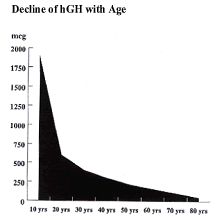 Somatotropin
is one of several endocrine hormones, like testosterone, estrogen, progesterone,
and DHEA - that decline in circulation as we age. While many of these hormones
are replaced to deter some of the effects of aging, somatotropin goes far beyond
the effect of any of these other hormones, to not only inhibit biological aging,
but to significantly reverse many of the effects of aging. Research has demonstrated
that rhGH therapy can reverse the biological markers of aging by as much as
twenty years within six months of therapy. 7, 13
Somatotropin
is one of several endocrine hormones, like testosterone, estrogen, progesterone,
and DHEA - that decline in circulation as we age. While many of these hormones
are replaced to deter some of the effects of aging, somatotropin goes far beyond
the effect of any of these other hormones, to not only inhibit biological aging,
but to significantly reverse many of the effects of aging. Research has demonstrated
that rhGH therapy can reverse the biological markers of aging by as much as
twenty years within six months of therapy. 7, 13